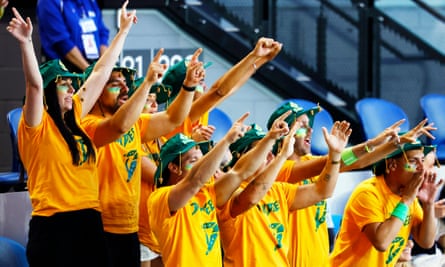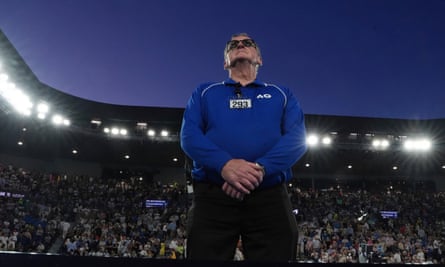The Australian Open has surged past last year’s cumulative attendance record with one day of play to go, and will ultimately draw nearly 1.1m patrons through the gates by Sunday night’s end of the 15-day tournament.
They have been drawn by the on-court action and off-court attractions, including new hospitality offerings and more family-friendly activities around Melbourne Park. Tournament director Craig Tiley hailed the result, and said “making sure that fans are comfortable is our major priority”.
But some believe the character of the event has changed. Former player John Alexander said on ABC on Saturday “there is a yobbo element of the crowd that are coming, whether it’s sometimes to cheer for their nationality or cause a problem”.
Another ex-professional Louise Pleming said she has noticed more instances this year of security “tapping on shoulders” people who have drank to excess. “I think now we’re starting to see more people going on to Kia [Arena] and the other [non-ticketed] stadiums where it’s a free ticket, but maybe they are just new tennis fans,” she said.

“They’re coming from soccer, football, basketball, and in a way, you’ve got to think – okay, we’re at least introducing them to the game – maybe there’s got to be a little bit more conversation with the players.”
Umpires have worked hard to minimise interruptions to play this year, but Tennis Australia has been satisfied with behaviour of fans. Tiley said the number of ejections would be reviewed at the end of the tournament, “but the percentage is down from last year”.

Behind the scenes, organisers are hailing the impact of CCTV technology that automatically detects and records the number of patrons at key locations. The new technology means Tennis Australia can sell more ground passes, because they can be confident to continue sales – rather than pause them as in previous years – if the data shows the site still has available capacity.
The cameras were installed in 2022, and have helped drive record attendances in the past three years. Knowing how many people are on the site had proven challenging in the past, as ground pass holders can walk out without being scanned. “The major difference between our event and say something held at the MCG is that there is no official seated capacity,” Tiley said.
The site was expanded in 2025 to include the youth-focused Topcourt area at the city end of the site. But Tennis Australia has also been able to maximise attendance when the site is close to capacity – setting a new daily record on the first Friday close to 100,000 – especially in the period between the day session finishing and the night matches beginning, as tens of thousands of fans leave the arenas and flood the precinct.
The technology analyses the video feeds to automatically count the number of bodies it detects in each location. Melbourne and Olympic Parks confirmed no biometric data is captured.
after newsletter promotion
Organisers use the information to make live decisions on what food and beverages stalls to open, how to staff ticketing booths at the entrances to the venue, and how to deploy security and safety measures during busy periods.
It also informs the design layout each year. This year two new bars were established alongside the main practice courts, which have added amenity and better crowd management to an area that had been prone to overcrowding.
Last week Tiley said Tennis Australia wanted an even larger site in coming years, as Melbourne Park begins work on a 20-year vision for the site.
Although this year’s tournament has set a new attendance record and has been largely free of incident, it has not been without challenges.
John Cain Arena’s virtual queueing system fell over on the first day, forcing organisers to set up physical lines – sometimes requiring hours of waiting in the sun – and hand out wristbands to provide access to the largest venue accessible to ground pass holders. “We found that this was the fairest way to provide access to ground pass holders,” Tiley said.


